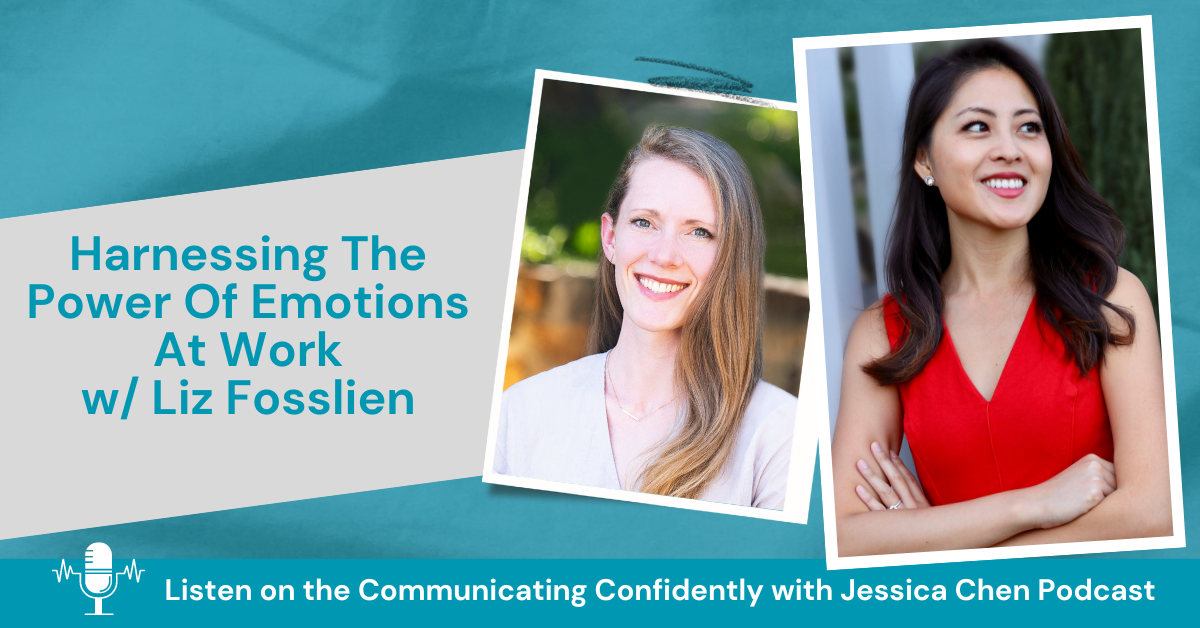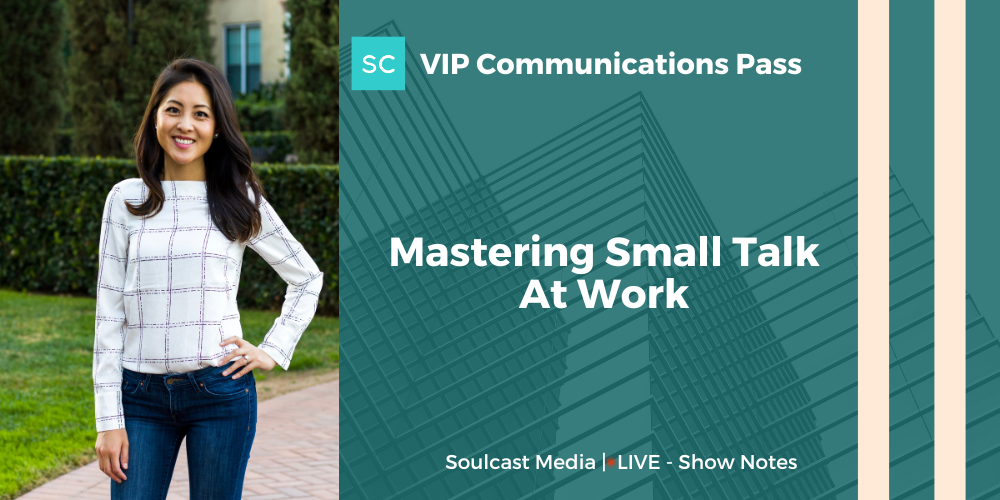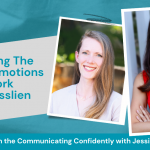Make Radical Candor Just Work
One of the most important skills for succeeding and being seen at work is the ability to communicate clearly and effectively, especially when confronted with tricky situations. Our CEO and Founder, Jessica Chen, recently hosted a Soulcast Media | LIVE event on LinkedIn, where she interviewed the Author of “Just Work” & “Radical Candor,” Kim Scott. They shared tips and personal stories about how to clearly and honestly communicate what you want.
📍LISTEN TO THE EPISODE ON OUR PODCAST
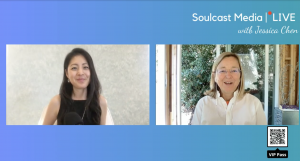
1. Radical Candor
Radical Candor requires two essential elements: caring personally and challenging directly. Consider the following:
- Caring – When it comes to showing others we care, we have to get on the same page as the other person we’re communicating with. For example, let’s say we are working with someone and we want to make a suggestion, instead of just diving in and saying, “Hey, I’ve got some ways to make this better,” we can start off by acknowledging their hard work. We might say , “Wow, I can tell you’ve invested a lot of time and effort into this project. It’s impressive!” And then, we gently introduce our ideas for improvement. So, we might say, “You know, I have a few suggestions that could take this project to an even higher level. Would you like to hear them?” By acknowledging other peoples efforts first and approaching the suggestions with a willingness to collaborate, you’re showing genuine care. It’s not about criticizing or tearing down what they’ve done; it’s about uplifting and working together to make things even better.
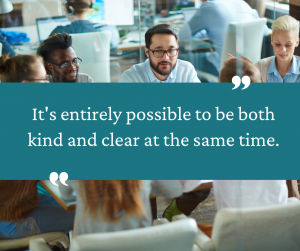
- Challenging – We all have this sense of responsibility to look out for one another. It’s like this obligation we feel to help someone out when we see they might be heading down the wrong path. During the Soulcast Media | LIVE, Kim shared a really eye-opening experience. She talked about how her former manager, being a caring individual, took her aside one day. They had this heart-to-heart conversation about something seemingly small but significant – Kim’s use of the word “um” during her presentations. Now, here’s the thing: that manager could have just ignored it, brushed it off, or even complained about it behind Kim’s back. But no, they chose a different path, one of genuine concern and a desire to help Kim grow. They saw the potential in her and realized that addressing this issue early on could prevent it from getting worse. So, they had that open and honest chat, not to criticize or embarrass Kim, but to offer some constructive feedback. And you know what? Kim appreciated it. She saw it as an opportunity to improve and refine her presentation skills. This story beautifully showcases how caring personally and challenging directly can make a huge difference in someone’s development. It’s not about pointing fingers or making someone feel bad about their mistakes. It’s about stepping up and supporting each other on our journey to become better versions of ourselves.
Sometimes people tend to think being kind means sugarcoating things or avoiding tough conversations altogether. However, it’s entirely possible to be both kind and clear at the same time.
2. Critical Feedback
Giving and receiving critical feedback can be quite a nerve-wracking experience for many of us. Many of us get a little anxious when it comes to those tough conversations. That’s why being strategic about how we approach feedback is essential.
Consider the following:
- Feedback – When it comes to giving feedback, starting off from a neutral place can be really helpful. It’s like finding that middle ground where both parties feel comfortable and open to the conversation. Imagine this scenario: you share your feedback with someone, and they react with sadness or anger. In that moment, it’s crucial to amp up the care direction. It’s like showing them that you genuinely care about their feelings and that your intention is not to hurt or upset them. It’s about being understanding and empathetic, creating a safe space for them to express their emotions. On the flip side, if the person brushes off your feedback and seems dismissive, it’s a signal to shift a bit toward the challenge directly direction. It’s like gently emphasizing the importance of what you’re saying and making sure they understand the gravity of the situation. It’s not about being confrontational, but rather ensuring that your message gets across effectively.
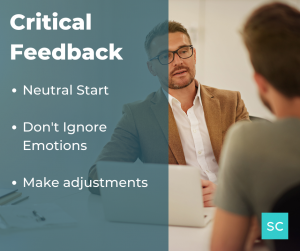
- Emotions – When it comes to dealing with emotions, it’s crucial not to sweep them under the rug. We can’t just ignore how people feel because emotions play a significant role in how we process things. Instead, we should strive to stay present with those emotions and approach them with a curious mindset, not a furious one. It’s like this: when someone expresses their feelings, we shouldn’t immediately get upset or angry about it. Instead, let’s be curious about why they feel that way. What’s causing those emotions? What can we learn from their perspective? By being genuinely curious, we open up the opportunity for deeper understanding and empathy.
- Make Adjustments – When it comes to giving feedback, being flexible is key to success. It’s like adapting our approach based on the situation and the person we’re interacting with. Not everyone responds the same way to feedback. Some may appreciate a more direct approach, while others might need a gentler touch. Being flexible means understanding what works best for each individual and tailoring our feedback accordingly. It’s like customizing our communication style to ensure it resonates with them.
Feedback is most effective when it’s a collaborative process. It’s not just about telling someone what to do or what they’re doing wrong; it’s about working together to find solutions and grow. Encouraging that open dialogue creates an environment where both parties can share their insights, learn from each other, and arrive at a common understanding.
3. Disrupting Bias
During the Soulcast Media | LIVE event, Kim shared some valuable insights about tackling bias in the workplace. When these moments of bias occur, it can feel pretty overwhelming – like a mix of panic and shame bubbling up inside us. In those moments, we need to analyze what’s happening. Let’s try to understand whether we just encountered bias, prejudice, or even bullying. By analyzing the situation, we gain clarity and a better grasp of what’s at play.
Consider the following:
- Bias – Bias often stems from unconscious thoughts or beliefs that we might not even be aware of. And when we come face to face with bias, responding with “I” statements can be a powerful way to handle the situation. Here’s how it works: Instead of pointing fingers or getting defensive, we can express our feelings and observations using “I” statements. It’s like saying, “Hey, I noticed this, and here’s how it made me feel.” For example, we might say, “I don’t think you meant it the way that it sounded.” By using “I” statements, we open up the conversation and invite the other person to understand our perspective.
- Prejudice – Prejudice, unlike bias, is a consciously held belief based on unfair and inaccurate stereotypes. And when we come across prejudice, using “It” statements can be a powerful way to address the issue head-on.
So, picture this: Instead of dancing around the problem or trying to avoid it, we can confidently respond with an “It” statement. For instance, we might say, “It is an HR violation” or “It is illegal.” These statements draw a clear line and make it known that such behavior is not acceptable.
- Bullying – Bullying is indeed a hurtful behavior, and when we encounter it, using “You” statements can be an assertive way to address the issue head-on. Imagine this: Instead of staying silent or feeling powerless in the face of bullying, we can stand up for ourselves with confidence. Using “You” statements allows us to directly address the person responsible for the hurtful behavior. For instance, we might say, “You can’t talk to me like this,” or “You need to stop treating me this way.” By using “You” statements, we assertively communicate our boundaries and make it clear that we won’t tolerate being mistreated.
When it comes to addressing bias, we can’t afford to stay silent or ignore it. If we don’t tackle it head-on, it has the power to disrupt our workplace and our relationships. So, being proactive and addressing bias in the moment is crucial.
Incorporating a little bit of radical candor into our communication style can go a long way in helping us navigate our careers and build stronger connections with others.
If you want to see the full LIVE version of Jessica and Kim’s conversation, check out Jessica’s Youtube Channel.
__
Whenever you’re ready, there are 3 ways we can help you:
- Discover your communications style so you know where to start. Over 4,000 people have found theirs here.
- Attend our monthly communication workshop to build communications confidence (new topics: public speaking, advocating for yourself, building credibility, etc) here.
- Get your brand in front of 43k+ people by sponsoring our newsletter or Soulcast Media | LIVE LinkedIn events [contact: hello@soulcastmedia.com]
Communication Resilience at Work
The art of people management is a crucial skill for any leader, supervisor, or manager who wants to ensure the success of their team and organization.
According to a recent survey, over 57% of unhappy employees leave their jobs because of their bosses.
Mastering the art of people management is increasingly important for organizations to remain competitive and achieve long-term success. To become excellent at people management, we need to have strong communications skills, and a willingness to listen more than we speak.
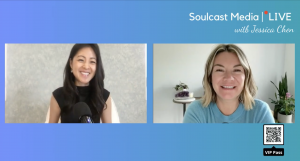 Our CEO and Founder, Jessica Chen, recently hosted a Soulcast Media | LIVE event on LinkedIn. She interviewed Chartered Psychologist and Author, Dr. Gemma Leigh Roberts.
Our CEO and Founder, Jessica Chen, recently hosted a Soulcast Media | LIVE event on LinkedIn. She interviewed Chartered Psychologist and Author, Dr. Gemma Leigh Roberts.
They shared tips and personal stories about communication resilience at work.
Resilience is our ability to overcome adversity and learn something from the situation which helps us to change things in the future.
We can use adversity to bounce forward.
The practice of doing something builds confidence.
Being uncomfortable doing something – giving a presentation, is a form of adversity.
Instead of looking at things as a failure, we need to look at them as learning experiences.
We can build our tolerance up slowly. Stepping outside our comfort zone a tiny bit at a time.
Finding ways to learn and grow isn’t all up to us. We can find mentors, take courses, ask colleagues – we can use the people around us.
Remind ourselves of a time we overcame a massive challenge. For example, getting a college degree. And we have to know we can do it again. It may not be perfect, but we know we’ve done it once, we can do it again.
We can use breathing techniques to calm our bodies down. Box breathing – breathe in for four seconds, hold for four seconds, breathe out for four seconds, and then hold for four seconds and repeat.
Everyone has to start somewhere. No one woke up and knew how to do anything.
Trial and error allows us to work from a place.
Our mindset needs work as well. Yes, we need skills, but we also have to be in the right mindset.
There are multiple ways we can say something and it can change how it is received.
How to find a mentor/sponsor at work? Are you taking on any mentees? Instead of will you be my mentor? Remember, they are people as well. One of the most important things is to constantly foster relationships with people. That relationship may help us later on.
Nothing good happens if we are just sitting and hoping. We have to put ourselves in positions to get more opportunities.
Be Upfront
Be Direct/specific – commitments
Be Kind/complimentary
Is the discomfort of asking worth missing out on the opportunity? Like, getting a raise, etc. If we let the imagined discomfort rule our lives, we will miss out on opportunities.
Most progress in life is done by us making things happen, rather than waiting for something to happen for us.
What do we do when we feel like we’re really discouraged? We’ve heard the word no too many times?
How can I cope and keep moving forward? People with really good support systems can bounce forward more easily. We can think about our experiences and reframe them. So much of resilience is about perspective and how we see the world. For example, can we change things into an experiment. I’m going to try something – I’m not sure how it will work out but I’ll try it. This can take the pressure off of things. An experiment rather than a solution, because we don’t know what the solution is yet.
How do we know when we need to give up? When is a situation no longer working for us, or it’s not healthy for us to continually adapting to something when it’s causing so much damage? Ask ourselves, is this worth it?
We often confuse grit, passion and perseverance, with resilience.
Resilience isn’t an end goal, it is something we have to keep working at.
How to overcome when your superior doubts you:
We can’t control other people, all we can do is control ourselves. So we can prove what we are capable of. Figure out what is in our control – see if there are opportunities to have a discussion about it. What can I do to improve my skills or get other opportunities? This can show the other person you are committed to doing something.
We don’t know everything – sometimes things happen that have nothing to do with us. There may be something going on with our superior that is impacting how they lead that has nothing to do with us.
Must have an honest conversation with the person – you have to show your willingness to improve, and really take into consideration what they are looking for. Show them, and communicate the process along the way – actions are more powerful than words.
Be committed to learning as we go. It’s okay to take a break.
Effective teamwork begins with open and honest communication and hearing what isn’t said.
Communication resilience is the ability to read between the lines.
Check out Jessica’s Youtube Channel for the full LIVE version of Jessica’s conversation.
__
Whenever you’re ready, there are 3 ways we can help you:
- Discover your communications style so you know where to start. Over 4,000 people have found theirs here.
- Attend our monthly communication workshop to build communications confidence (new topics: public speaking, advocating for yourself, building credibility, etc) here.
- Get your brand in front of 43k+ people by sponsoring our newsletter or Soulcast Media | LIVE LinkedIn events [contact: hello@soulcastmedia.com]





